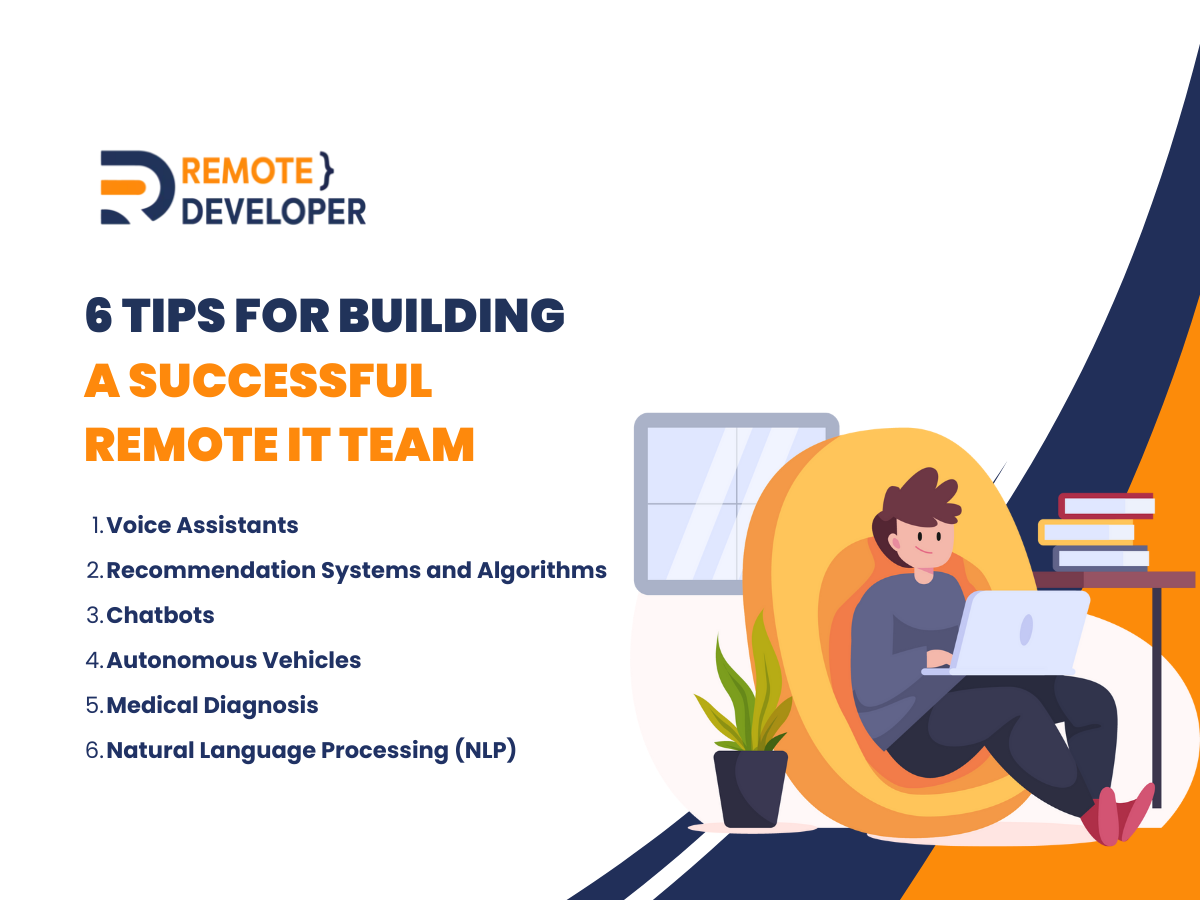In an era marked by the dynamic evolution of the workplace, the concept of remote teams has become integral to the fabric of modern business operations. Nowhere is this truer than in the realm of Information Technology (IT), where the ability to effectively collaborate across distances has become a defining factor for success.
And as organisations increasingly embrace the advantages of remote work, the challenge of cultivating and managing a successful remote IT team takes centre stage. In this article, we delve into the intricacies of this endeavour, offering six pivotal tips for building a successful IT team that can serve as a compass for organisations seeking to establish and nurture a thriving remote IT team.
What is a Remote IT Team?
A remote IT team is a group of highly skilled professionals working remotely to provide various IT services and support. Instead of being physically present in a traditional office setting, these individuals collaborate virtually using advanced communication and collaboration tools.
Usually, they are composed of professionals specialising in different areas, such as software development, network administration, cybersecurity, and technical support. These individuals bring their expertise and knowledge to the table while working independently from their locations.
5 Advantages of Remote IT Teams
The rise of remote work has allowed businesses to tap into numerous benefits, including the global talent pool, lower hiring costs, and more. Each advantage has reshaped how companies conduct their business, operations, and workplace.
As such, here are five key benefits of hiring a remote IT Team:
Global Talent Access
One of the most significant advantages of hiring remote IT teams is the ability to tap into a global talent pool. With traditional office-based setups, geographical constraints often limit the recruitment options for organisations. However, businesses can access skilled IT professionals worldwide by embracing remote work.
This diversity in talent brings a range of perspectives and expertise and allows organisations to build teams with the specific skill sets required for their projects. The result is a more versatile and dynamic IT workforce that can tackle challenges from different angles, fostering innovation and creativity.
Enhanced Flexibility and Work-Life Balance
Remote IT teams offer team members the flexibility to structure their work in a way that suits their preferences and lifestyles. This flexibility can improve work-life balance, as team members can better manage their time and align their work hours with their most productive periods.
Providing IT professionals, the autonomy to set their schedules increases job satisfaction and reduces burnout. As a result, remote IT teams often exhibit higher levels of motivation and engagement, ultimately leading to more productive outcomes for the organisation.
Increased Productivity and Efficiency
Contrary to conventional concerns, remote IT teams often demonstrate increased productivity and efficiency. Removing daily commutes, office distractions, and rigid working hours allows team members to focus on tasks without interruptions. Additionally, the flexibility to choose a work environment that suits individual preferences can lead to heightened concentration and output.
Moreover, remote collaboration tools and project management platforms empower IT Team Productivity to coordinate seamlessly, ensuring that projects progress smoothly even when team members are physically dispersed. This efficiency is further amplified by the ability to work across different time zones, enabling a continuous workflow and faster project turnaround times.
Cost Effective Workforce
Remote IT teams contribute significantly to cost savings for organisations. Companies can save on office rent, utilities, and maintenance expenses by reducing the need for physical office space. Moreover, organisations can cut down on overhead costs associated with providing on-site amenities.
From the perspective of IT professionals, remote work eliminates commuting costs and time, leading to increased job satisfaction. This can be a crucial factor in attracting and retaining top-tier talent, as many IT professionals prioritise the flexibility and autonomy offered by remote work arrangements.
Business Continuity and Disaster Recovery
The COVID-19 pandemic underscored the importance of having a flexible and resilient workforce. Remote IT teams proved invaluable in ensuring business continuity during unprecedented times. Organisations with established remote work capabilities could seamlessly transition to fully remote operations, maintaining productivity despite disruptions.
Additionally, remote work inherently enhances disaster recovery capabilities. With data and operations decentralised, organisations are less vulnerable to localised disasters, ensuring that IT functions can continue, even if some geographic regions are affected.
5 Challenges of Remote IT Team Management
While remote IT team management offers magnificent benefits, like other workforce, it faces various challenges that can hinder success and effectiveness. To address these issues, here are five challenges that you should be aware of:
Communication Barriers
One of the most common issues in a Remote IT Team is communication Barriers. Remote teams often miss out on the informal, face-to-face communication that naturally occurs in an office setting. This can lead to misunderstandings, misinterpretations, and a weaker team bond.
Similarly, coordinating team meetings and collaboration becomes challenging when team members are spread across different time zones. Scheduling regular meetings that accommodate everyone can be a logistical challenge.
Team Collaboration
In an office, team members can easily collaborate spontaneously. Remote work may lack this element, making it necessary to actively facilitate and encourage collaboration through digital tools, which might not be as effective as in-person interactions.
Monitoring and Productivity
Monitoring and productivity are another widespread concern of many when hiring a Remote IT team. Remote employees might face more distractions at home than in a dedicated office environment, potentially affecting their focus and productivity.
Likewise, monitoring the productivity of remote team members can be challenging. Finding the right balance between giving autonomy and ensuring that work is progressing as planned without micromanaging is essential.
Team Building and Culture
Building a Strong Team Culture is essential, even in remote IT Teams. However, building a strong team culture and a sense of belonging can be challenging. Remote employees may experience feelings of isolation due to the lack of in-person social interactions. This can contribute to burnout if not addressed, emphasising the importance of promoting work-life balance.
Likewise, managers must foster a positive work environment through virtual team-building activities, regular check-ins, and promoting a shared team identity.
Security Concerns
Managing IT teams remotely introduces additional challenges related to data security. Controlling access to sensitive information and systems becomes more complex when team members work from various locations.
Likewise, ensuring that remote team members follow security protocols, use secure networks, and are aware of potential cybersecurity threats is crucial. Implementing robust access controls and regularly updating security measures are essential in mitigating potential risks.
6 Key Tips for Building a Successful Remote IT Team
Building a successful remote IT team is not a walk in the park. It is an arduous process that comes with its own sets of challenges and opportunities. Moreover, it requires a combination of clear communication, trust, technology investment, team building, professional development, and a focus on work-life balance.
So, to help you with that, here are six (6) tips to help organisations establish and maintain a thriving remote IT team.

Prioritise Effective Communication
Communication lies at the heart of building a successful IT team, especially for remote IT teams. In a traditional office setting, casual conversations at the water cooler or impromptu meetings in the hallway can contribute significantly to team cohesion. In a remote environment, virtual communication channels often replace these informal interactions, which can sometimes cause miscommunications.
Likewise, it’s important to establish transparent and efficient communication protocols to ensure that team members can easily connect and collaborate. Define and document communication protocols to ensure everyone is on the same page. This should include guidelines for responding to emails, expected response times, and the appropriate use of communication channels.
Moreover, invest in robust collaboration tools that facilitate seamless communication. Platforms like Slack, Microsoft Teams, or Asana provides channels for both formal and informal discussions. Regular team meetings, video conferences, and instant messaging can help bridge the communication gap and foster a sense of connectedness.
Promote a Culture of Trust
Trust is the cornerstone of building a successful IT team. When team members trust each other, they are more likely to collaborate effectively and contribute to the team’s success. Building trust in a remote IT team requires intentional efforts from leadership and team members.
Communicating expectations, goals, and deliverables is one way to build trust. Remote team members should comprehensively understand their roles and responsibilities and the overall objectives of the projects they are working on. Establishing transparent expectations helps prevent misunderstandings and builds trust among team members.
Similarly, focusing on the outcomes rather than micromanaging the process is essential. Remote work often allows for more flexibility in how and when tasks are completed. Trust your team to manage their time effectively and deliver quality results.
Finally, always create an environment where team members feel comfortable expressing their thoughts and concerns. Regular check-ins, one-on-one meetings, and anonymous feedback mechanisms can contribute to open and honest communication.
Cultivate a Positive Team Culture
Social interactions are crucial in building a successful IT team and creating a positive and collaborative work environment. Likewise, creating camaraderie among remote team members is essential for team cohesion and employee satisfaction. It can help overcome the physical distance between team members.
Remember to foster a positive remote team culture by organising virtual IT team-building activities. Despite physical distances, team-building activities can be conducted virtually. Online games, virtual happy hours, and collaborative projects can unite team members, fostering a sense of belonging.
Another way to cultivate a positive culture is through celebrating achievements. Recognise and celebrate the accomplishments of individual team members and the team. Acknowledging achievements, milestones, and hard work boosts morale and reinforces a positive team culture.
Lastly, always encourage open communication. Provide opportunities for casual interactions. Establish virtual “water cooler” spaces where team members can engage in non-work-related conversations, helping to replicate the spontaneous interactions of an office setting.
Invest in Professional Development:
Investing in remote IT team members’ professional development is crucial for promoting individual growth and building a successful IT team. And remote work settings should not hinder career advancement and skill enhancement opportunities.
Always provide opportunities for professional development and training. Remote IT teams should have access to resources that help them stay updated on the latest technologies and industry trends. Offer access to online courses, webinars, and relevant learning materials. Encourage team members to continuously upgrade their skills to stay abreast of industry trends and technologies.
Likewise, establish mentorship programs to facilitate knowledge transfer and skill development. Pairing less experienced team members with seasoned professionals creates a supportive learning environment and strengthens the team’s overall skill set.
This enhances individual skills and contributes to the team’s overall success.
Prioritise Work-Life Balance
Maintaining a healthy work-life balance is crucial for building a successful IT team and ensuring the well-being and productivity of remote IT team members. The lack of physical boundaries between the office and home can blur the lines, leading to potential burnout and decreased job satisfaction.
Likewise, always establish clear expectations regarding work hours and availability. Encourage team members to define and stick to their working hours, promoting a healthy separation between work and personal life. Moreover, encourage team members to take breaks, use their vacation time, and step away from work when needed. A well-rested and rejuvenated team is more productive and creative.
Lastly, Keep a close eye on team workload and stress levels. Regular check-ins and open communication can help identify signs of burnout early on. Implement strategies to redistribute tasks, provide additional support, or adjust timelines as necessary.
Establish Robust Security Measures and Provide Awareness Training
Security is paramount when managing a remote IT team, as they deal with sensitive data and have access to critical systems. Strengthening cybersecurity ensures the team operates securely, protecting the organisation and its clients.
Prioritise cybersecurity by implementing regular security awareness training for remote team members. This includes educating them about best practices for data protection, secure communication, and recognising potential security threats. A well-informed team is better equipped to handle security challenges.
Likewise, implement tools and processes to monitor and audit sensitive data and systems access. Regularly review permissions and access levels to ensure only authorised personnel can access critical resources.
Conclusion
In conclusion, building a successful remote IT team requires a strategic blend of effective communication, trust-building, employee well-being, and robust project management. It is not merely about adapting to a new way of working but about harnessing a team’s full potential that transcends geographical boundaries.
These six essential tips, augmented by additional insights, can help you initiate and sustain a high-performing remote IT team. So, what are you waiting for? Are you ready to build a high-performing remote IT team? Explore these six tips with Remote Developer and start transforming your IT workforce for the digital age! Contact us now!

